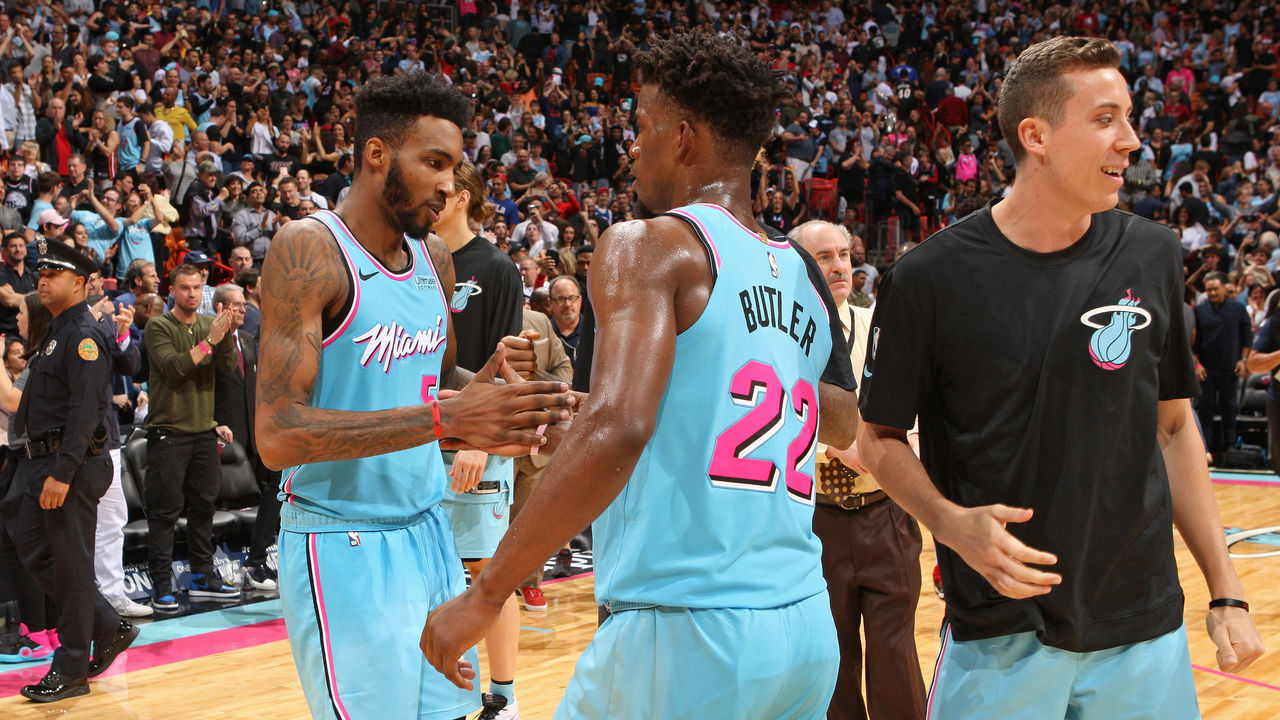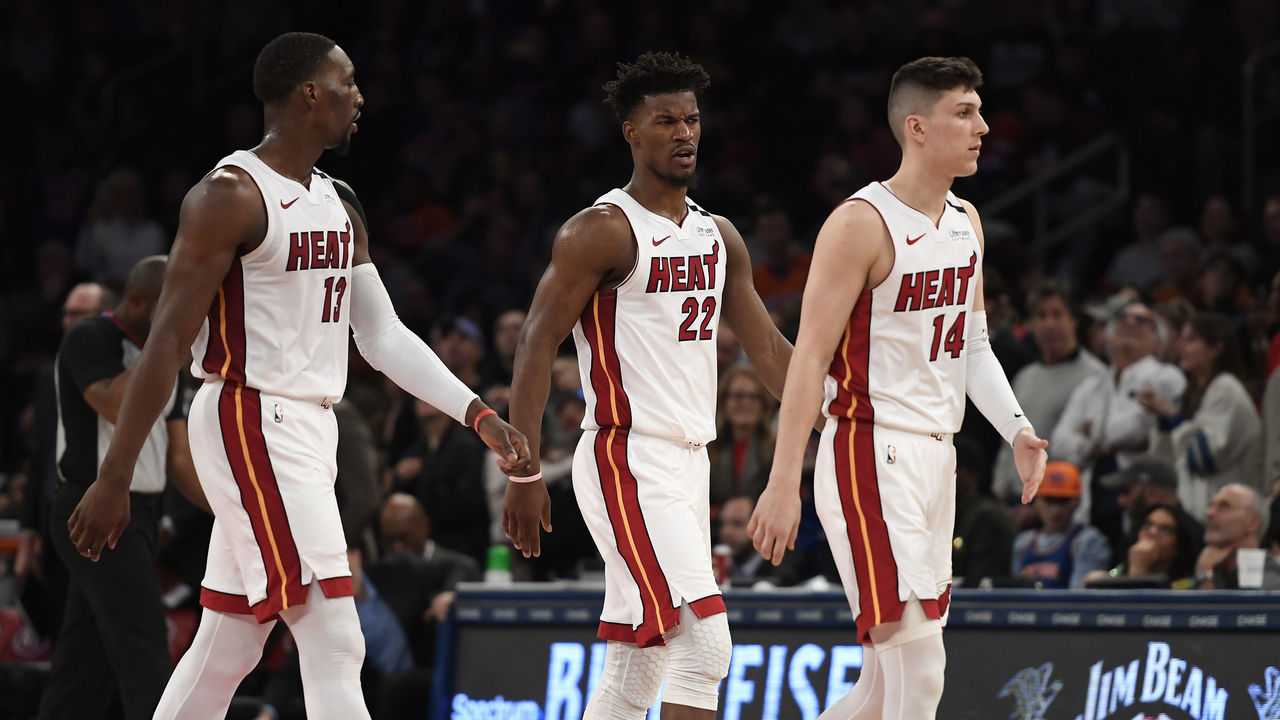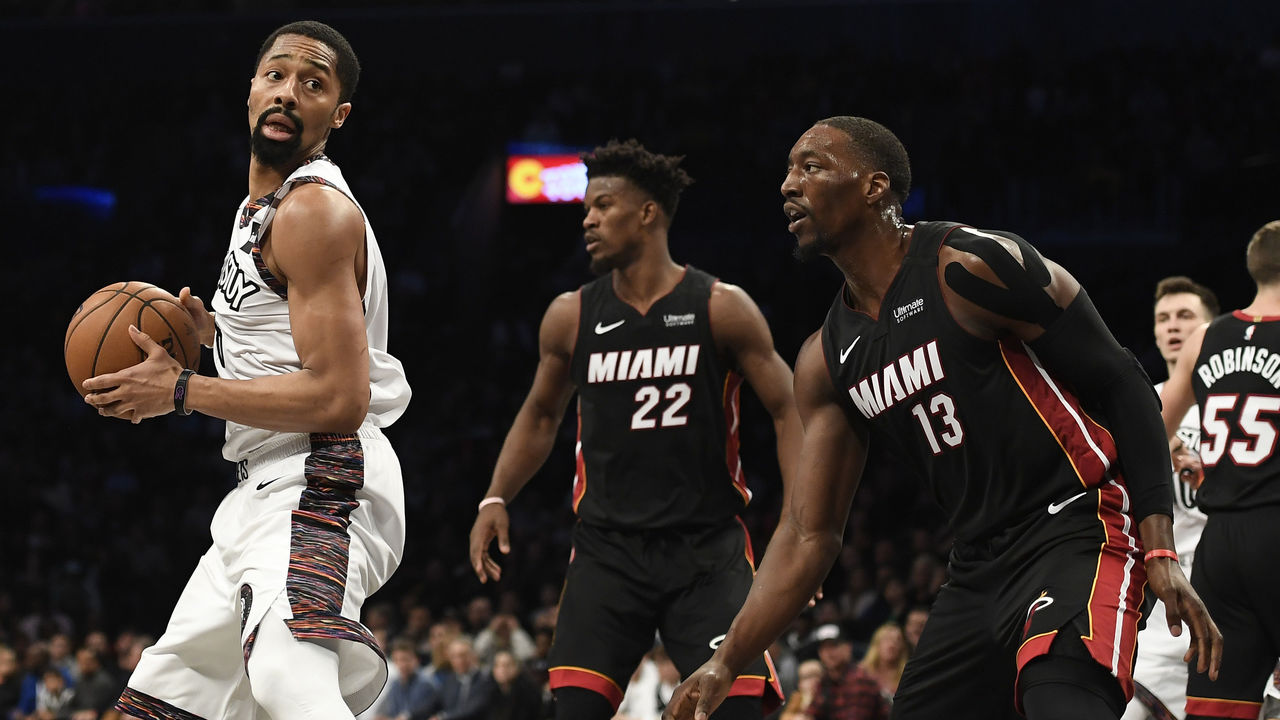How far can the Heat push their zone defense?
Ever since head coach Erik Spoelstra turned to it out of injury-induced desperation early last season, the Miami Heat have been at the forefront of the NBA's collective tilt towards zone defense.
A lot of teams are mixing in zone this season (17 teams have used it for at least 50 possessions), but the Heat are lapping the field in terms of usage for the second straight year, having deployed it on 12.3% of their possessions and played 168 more possessions of it than the next-closest team, the Washington Wizards, according to Synergy. Unlike the Wizards, though, the Heat have succeeded using the approach, ranking sixth among those 17 teams in points allowed per zone possession.
The Heat's defense as a whole has been slipping for a while now - they're down to 14th in the league in defensive efficiency for the season, and rank 23rd over their past 25 games - and the zone's effectiveness hasn't been exempt from that slippage. But on the whole, the scheme's unquestionably been a success. Miami owns a 96.3 defensive rating in half-court man-to-man coverage, compared to 91.5 in the zone, according to Synergy. For reference, the league's median defensive rating in all half-court scenarios is 96.4.
That leads to two questions: What makes the Heat inclined to frequently use the zone, and why is it working when they do?

Let's start with the "how." First, personnel obviously matters. (For proof, look at the Wizards, who rank last in the NBA in defensive efficiency.) Having a hyper-athletic, long-armed wing like Derrick Jones Jr. at the top of the zone certainly helps, as does having a cinder block on wheels in Bam Adebayo anchoring the back end of it. The addition of Jimmy Butler to the mix has only strengthened Miami's first line of defense.
Busting a zone is a matter of finding the seams in it - passing or cutting through or around it - and the Heat are good at keeping those corridors narrow and closing gaps in a hurry. Even something as simple as entering the ball into the middle of the zone isn't a particularly safe proposition when Jones (No. 5) and Butler (No. 22) are patrolling the top:
But the physical component is only part of the battle. The rest is a matter of focus, intuition, and communication. To that effect, it's beneficial to have Butler and Adebayo, who are not only intensely physical players, but two of the smarter defenders in the league. There's a marriage of kineticism and connectedness that makes it work.
"It's one of those things that it's a feel thing," Adebayo told reporters earlier in January, according to the Miami Herald's Anthony Chiang. "You start to learn chemistry with your teammates. I think the big thing about the zone is we talk more. I feel like that's the big deal about the zone. We're really talking and communicating. You're talking yourself into spots."
Butler freelances within the zone more than anyone else, reading and reacting and roving and wreaking havoc. And Adebayo (No. 13) can play either spot on the three-man back line in a 2-3 alignment - either protecting the paint in the middle, or snuffing out the corner and wing. He has the combination of size, speed, and footwork to handle both assignments. Sometimes he effectively does both on the same possession:
Adebayo's flexibility allows the Heat to play big or small, with Meyers Leonard occasionally manning the middle of their zone. Staying as close as possible to the basket helps mitigate a lot of Leonard's limitations as a defender in space, while his ability to stretch the floor allows him and Adebayo to flip-flop roles at the offensive end, with Leonard spotting up as the nominal four while Adebayo goes to work inside the arc.
That gets at a big part of the "why" portion of this equation, too. One of the biggest benefits of the zone is that it can mask weaknesses in individual defenders, and the Heat have a number of those weaknesses in their regular rotation.
Being without Justise Winslow for most of the season has probably nudged them further away from man-to-man coverage, because outside of Jones and Butler, their perimeter rotation is quite flawed defensively, and Jones cripples their spacing too much at the other end to play big minutes. Guys like Duncan Robinson, Kendrick Nunn, Tyler Herro, and Goran Dragic - who are crucial to Miami's offense but are at best average individual defenders (and in some cases worse than that) - can still thrive when they're asked to guard areas instead of players.
In the zone, the Heat often have those wing defenders position themselves in exaggeratedly angled stances, almost with their backs to the sideline when the ball is at the top. It speaks to how staunchly Spoelstra wants his defense's attention to be focused on the middle of the floor. Have a look at Nunn and Herro on the wings here:

Like the Bucks, Raptors, Celtics, and several other top defenses this season, the Heat have decided that surrendering a high volume of 3-point attempts is something they're willing to live with if it means deterring shots at the rim. The Bucks in particular have demonstrated how successful that approach can be. Even in man coverage, the Heat pack the paint and help aggressively at the nail, which redistributes a large share of opponent shots to 3-point range. Only the Raptors' defense concedes a higher proportion of shot attempts from beyond the arc.
The difference is that Miami, unlike most of those other interior-focused defensive teams, doesn't actually do a good job of forcing misses at the rim. In fact, the Heat allow the league's third-highest opponent field-goal percentage inside the restricted area, which makes it doubly important for them to prevent opposing teams from getting there in the first place. The zone helps in that regard, specifically when it comes to limiting straight-line drives to the rim. They wisely ramp up their usage of it against teams like the 76ers who are light on high-end off-the-dribble attackers.
Their defensive field-goal percentage at the rim may also have to do with one of the major drawbacks of the zone, which is that it leaves the defensive team vulnerable on its own glass. (Because defenders aren't stapled to any particular offensive player, it can be difficult to box out all five guys in the time it takes for a shot attempt to go up and come off the rim.) Offensive rebounds create opportunities for putbacks, which have a far higher conversion rate than other at-rim shots. The Heat have actually managed to employ the zone without significantly compromising their defensive rebounding rate - which currently ranks third in the NBA - but they allow 1.24 points per second-chance possession, the second-worst mark in the league, according to Synergy.
Miami has been buoyed all season by an unusually low opponent 3-point field-goal percentage (currently the lowest in the league at 32.9%), which historical data tells us is more difficult for a defense to control than opponent 3-point volume. Considering how many of those attempts they give up, it's a bit scary to think what may happen if the Heat's 3-point defense regresses to the mean.
But there's reason to believe that won't happen. For all their focus on locking down the interior, the Heat do an excellent job of recovering out to shooters and taking space away. According to Synergy, Miami is contesting a higher percentage of opponents' catch-and-shoot attempts than any other team in the league at 47.9 percent. With that in mind, it's fair to wonder whether their opponent 3-point volume isn't as much about opponents struggling to puncture the zone as it is about those opponents actually generating the shots they want.
In the meantime, there are other advantages. You don't typically think of a zone as an aggressive defensive scheme, but the Heat can play it aggressively, particularly in the way they prowl the passing lanes. As a result, they force turnovers at a higher rate in the zone than they do in typical man coverage. Meanwhile, their rate of shooting fouls committed dips from 9.2% in man defense (tied for the worst mark in the league) to 6.7% in the zone. That obviously doesn't paint a complete picture of the scheme's benefits and drawbacks, but upping takeaways while reducing fouls is an important and very difficult two-pronged outcome to produce. The benefits, so far, have won out.

That doesn't mean it's always going to pay off, or should even be used in anything other than small doses. Part of what's made the zone effective the past couple seasons is the element of surprise, and the Heat no longer have that.
Against the Kings last week, for instance, the Heat stubbornly stuck with their zone for almost the entire game, despite the fact they got torched on their own glass and picked apart from the inside out by Nemanja Bjelica. The Kings came prepared with canny cutting and screening actions specifically designed to pry open the zone:
The Heat stuck with it regardless, and ultimately won the game while posting a very respectable 104.6 defensive rating - far better than their season-long rating and equivalent to the third-best mark in the league. Crucially, they took the Kings out of their regular offense, which is predicated on De'Aaron Fox drive-and-kicks. Even when Fox was able to get past the first line of defense, he was mostly relegated to shooting floaters, which isn't really his game. Otherwise, he could only swing the ball around the perimeter or hoist contested jump shots on his way to shooting 0-of-7 from distance. The Kings as a team shot 13-of-51 from 3-point range.
There's often a disconnect in basketball between how a tactic looks on a micro level and the results that tactic produces on a macro level. (Drop coverages are a good example of this. When a pick-and-roll ball-handler drains a pull-up jumper while the drop defender cedes him 10-plus feet of space, it looks disastrous. But the math typically paints those types of shots as more favorable for the defense than the alternatives.) The Heat zone itself wasn't as effective in the Kings game as it ordinarily is, but that doesn't mean it was a wrongheaded approach. They've proven time and again that they can execute it well.
At the end of the day, every scheme is going to have cracks, and every scheme is liable to exploitation given extensive exposure. The whole crux of modern defense is deciding which cracks you are and aren't willing to live with. A scheme itself is also never a guarantee of success. The execution of that scheme is always going to vary from game to game, possession to possession. You can make a case that there's a slimmer margin for error in the zone - that mistakes are easier to recover from, and holes easier to patch, in man-to-man coverage - but that would be largely anecdotal.

The goal is always flexibility; an ability to toggle between multiple coverages tailored to specific personnel and opponents. The NBA is situation-specific in every respect, and any scheme can be picked apart by the right opponent on the right day. As a general rule, the longer a team sees a particular design, the better they're going to understand how to bust it. Everything in moderation, in other words.
The Heat finished in the lottery last year, so we didn't get to see whether their zone could hold up to postseason scrutiny. This spring, we will. Odds are they'll end up using it as more of a small-dosage fallback than a staple of their defense in the highest-leverage moments. There likely isn't going to be a situation in the playoffs where they zone up for almost an entire game, as they've done against the 76ers, Kings, and an undermanned Raptors squad this season.
"It’s just another thing that we can throw at different teams at any certain time," Butler told Chiang. "We're good at it, to tell you the truth. And we're getting better at it. But I think our man-to-man is really going to be what we're going to have to bank on."
If or when the Heat have their full complement of players healthy, they should be better able to rely on their man-to-man defense. But the zone will still be an ace up their sleeve, one they'll be able to bust out in a pinch to junk up an opponent's flow. They'll have had more practice than any other team at nailing down the finer points of that rhythm-busting scheme, and they'll know it can be successful in select spots against a couple of opponents they may well see in the Eastern Conference playoffs. There's a good deal of value in that.